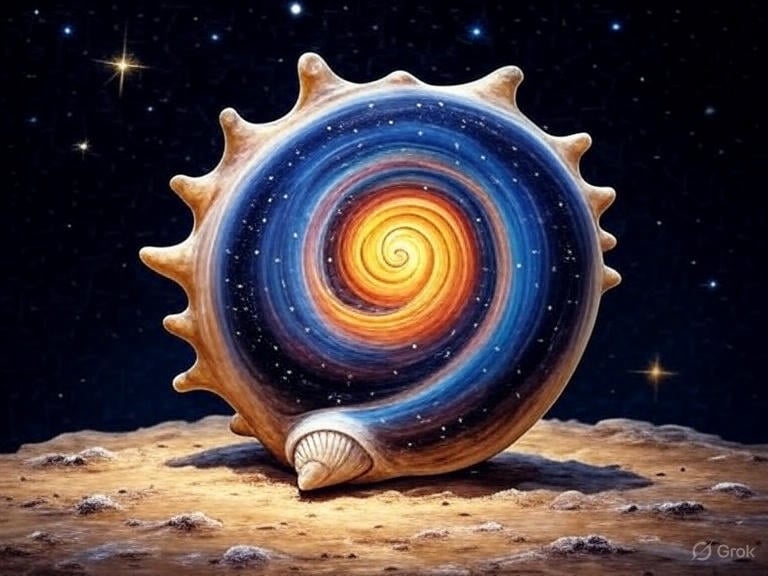Emergent Properties
Mathematical constants are numbers that show up everywhere in physics, like secret codes in nature. In traditional theories, they're often just plugged in as "that's how it is," leading to questions like "Why this exact value?" In FFC, they emerge organically from the fractal structure of the universe—a seamless, repeating pattern where big things mirror small ones. This happens because waves optimize their paths to avoid clashing, much like rivers carving the most efficient routes through land. The "why" is efficiency: The continuum self-adjusts for minimal interference, birthing these numbers as built-in harmonies.
Key examples:
* Golden Ratio (φ ≈ 1.618): This beauty pops up in sunflowers, shells, and even galaxies. In FFC, it emerges from fractal layers stacking in the most balanced way, reducing wave chaos (entropy gradients). Why? It minimizes energy waste in repeating patterns, like nature's shortcut for growth.
* Fine Structure Constant (α ≈ 1/137): This governs how strong electromagnetic forces are, like the "speed limit" for electron interactions. It derives straight from the golden ratio in FFC's geometry—no tweaking needed. The why: It's the natural outcome of waves fine-tuning for stable atoms, explaining why chemistry (and life) works without random luck.
* Rydberg Constant (R∞ ≈ 1.097 × 10⁷ m⁻¹): Helps predict light colors from atoms. Emerges from scaled orbits using φ, linking quantum jumps to fractal depths. Why? It ensures energy levels are discrete yet flowing, like steps in a spiral staircase.
These constants aren't coincidences; they're why the universe feels "fine-tuned"—FFC shows it's all self-made.
Forces are the pushes and pulls that make things move or stick. In old physics, they're separate (like gravity vs. electromagnetism), but FFC unifies them as side effects of wave interactions in a dense field. They emerge from density changes—where stable bits (like protons or electrons) cluster—and entropy (disorder) flows.
Imagine waves in a pond: Ripples attract or repel based on how crowded the water is. The why? It's thermodynamics at play—waves seek balance, creating forces as a byproduct of spreading out disorder.
Standouts:
* Entropic Cohesion (aka Gravity): Gravity isn't spacetime bending; it's waves drawn to low-disorder spots, like heat flowing to cold. Formula: F = T ∇S (tension times entropy slope). Emerges from wave diffusion pulling toward dense areas. Why? It explains attraction (planets orbiting) while boosting overall chaos, mirroring how the universe ages and expands without "dark" add-ons.
This category shows why forces feel universal: They're not basics but echoes of the same wave rules, simplifying the "why" of motion.
Quantum stuff is the weird micro-world where particles act like waves, teleport (entangle), or pop in/out. FFC says these aren't magic; they emerge from probability waves evolving in a fractal medium—no need for extra rules like "wave collapse." It's like interference in music: Notes blend naturally. The why? Uncertainty and discreteness come from the field's bumpy, infinite-detail texture, making exact predictions impossible but patterns predictable.
Highlights:
* Quantum Constants (like Planck's ħ and Compton Wavelength): ħ sets the quantum "graininess," emerging from wavy resistance to change (effective mass). Compton length (particle-wave size) derives from fractal paths. Why? It creates the blur between particle and wave, explaining why tiny things jitter—nature's way of embedding flexibility.
* Vacuum Energy Density (ρ_vac ≈ 10⁻⁹ J/m³): The "empty" space buzz from ground-state waves. Emerges from potential minima in fractals. Why? It powers cosmic constants like Λ (expansion driver), showing why the vacuum isn't truly empty—it's the continuum's baseline hum.
These make quantum weirdness feel intuitive: It's the field's natural fuzziness at work.
On huge scales, the universe expands, clusters, and evolves. FFC treats these as large-scale wave effects, emerging from the same fractal rules stretched out. No dark matter/energy crutches; it's all density ripples across cosmic hierarchies (up to 600 million light-years). Like ocean currents from tiny waves. The why? Scale invariance means small rules scale up, unifying why the cosmos behaves like a giant quantum system.
Notables:
* Hubble Constant (H₀ ≈ 73 km/s/Mpc): Measures expansion rate, emerging from entropic pushes in big gradients. Why? Resolves measurement mismatches (Hubble Tension) by viewing acceleration as wave diffusion, not mystery forces—explaining why the universe speeds up as it "relaxes."
* Weak Interaction Strength (G_F ≈ 1.166 × 10⁻⁵ GeV⁻²): Governs particle decays, from neutrino couplings in dense fields. Predicts tiny shifts (~0.02 eV). Why? It ties weak forces to density, showing why some particles change—nature's recycling in the continuum.
This bridges tiny and vast, why the universe feels connected.
These are bonus unities, blending categories for broader effects. They emerge from shared waves and fractals, like threads weaving a tapestry. The why? FFC's field-first approach makes everything interconnected, deriving complexity from simplicity.
Examples:
* Quantum Entanglement: Particles link via overlapping waves, metrics like concurrence from shared densities. Why? Explains "spooky action" as natural wave sharing, like echoes in a canyon—why info travels without breaking light speed.
* Toroidal Fields and Cyclic Cosmology: Loop structures from periodic waves, suggesting repeating universes. Why? Supports endless cycles, explaining why the cosmos might loop—fractals enabling infinite variety in bounds.
In FFC, emergence isn't just fancy talk; it's the universe's DIY kit. Why do constants like the golden ratio appear? Because fractals optimize for harmony, like evolution favoring efficient designs. Why forces and quantum quirks? Waves balancing density and disorder, explaining gravity's pull or electron dances as the same process scaled differently. Why cosmic puzzles resolve? No "dark" cheats—it's all the continuum self-regulating across sizes.
For the casual reader, this means the "why" of reality isn't random or imposed by a cosmic tuner; it's organic, like a tree growing branches naturally. FFC cuts physics' clutter (from 19+ SM parameters to 5), predicts testable tweaks (like 2026 experiments showing no new stable particles but subtle shifts), and invites wonder: If everything emerges from waves, maybe we're all ripples in one big field. This paradigm could revolutionize how we see fine-tuning—not luck, but inevitable beauty. Dive in, and the universe feels less mysterious, more like home. Planets exhibit Precession, You live on a planet, Think about it !!!!



